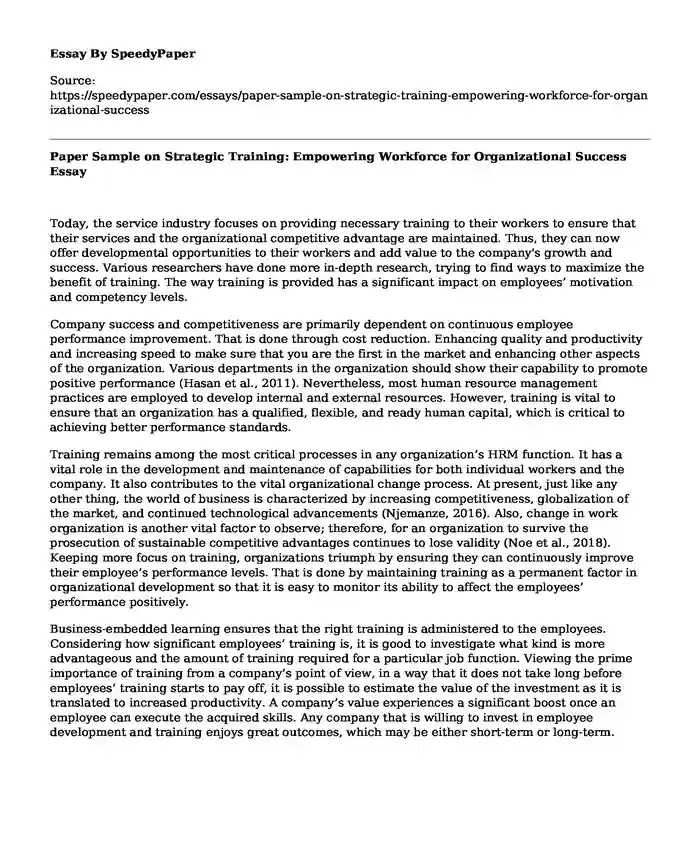
| Type of paper: | Essay |
| Categories: | Company Business Employment Development |
| Pages: | 3 |
| Wordcount: | 644 words |
Today, the service industry focuses on providing necessary training to their workers to ensure that their services and the organizational competitive advantage are maintained. Thus, they can now offer developmental opportunities to their workers and add value to the company's growth and success. Various researchers have done more in-depth research, trying to find ways to maximize the benefit of training. The way training is provided has a significant impact on employees’ motivation and competency levels.
Company success and competitiveness are primarily dependent on continuous employee performance improvement. That is done through cost reduction. Enhancing quality and productivity and increasing speed to make sure that you are the first in the market and enhancing other aspects of the organization. Various departments in the organization should show their capability to promote positive performance (Hasan et al., 2011). Nevertheless, most human resource management practices are employed to develop internal and external resources. However, training is vital to ensure that an organization has a qualified, flexible, and ready human capital, which is critical to achieving better performance standards.
Training remains among the most critical processes in any organization’s HRM function. It has a vital role in the development and maintenance of capabilities for both individual workers and the company. It also contributes to the vital organizational change process. At present, just like any other thing, the world of business is characterized by increasing competitiveness, globalization of the market, and continued technological advancements (Njemanze, 2016). Also, change in work organization is another vital factor to observe; therefore, for an organization to survive the prosecution of sustainable competitive advantages continues to lose validity (Noe et al., 2018). Keeping more focus on training, organizations triumph by ensuring they can continuously improve their employee’s performance levels. That is done by maintaining training as a permanent factor in organizational development so that it is easy to monitor its ability to affect the employees’ performance positively.
Business-embedded learning ensures that the right training is administered to the employees. Considering how significant employees’ training is, it is good to investigate what kind is more advantageous and the amount of training required for a particular job function. Viewing the prime importance of training from a company’s point of view, in a way that it does not take long before employees’ training starts to pay off, it is possible to estimate the value of the investment as it is translated to increased productivity. A company’s value experiences a significant boost once an employee can execute the acquired skills. Any company that is willing to invest in employee development and training enjoys great outcomes, which may be either short-term or long-term.
Conclusion
To sum up, the point of employing the business-embedded learning function is to make sure that employees are empowered with the proper skills to execute their jobs as expected. Today, the business situation has experienced tremendous changes that severely strain companies in their struggle to stay ahead of their competitors through improvements and enhancements. In the point above, contributing to organizational success, training activities should be utilized to enable the company to achieve its business strategy. That can be enhanced by developing the necessary skills and the required performance standards among individual workers. The link between individual performance and the strategy used in business occurs in part through organizational capacity whereby it creates and embeds workers along several dimensions.
References
Hasan, S. A., Subhani, M., & Rahat, O. (2010). Effects of Business Embedded & Traditional Training Models on Motivation. SSRN Electronic Journal. https://doi.org/10.2139/ssrn.1702196.
Noe, R. A., & Kodwani, A. D. (2018). Employee training and development, 7e. McGraw-Hill Education. https://www.mheducation.com/highered/product/employee-training-development-noe/M9781260043747.html
Njemanze, I. What Does Being a Strategic HR Business Partner Look Like in Practice? DigitalCommons@ILR. https://digitalcommons.ilr.cornell.edu/student/101/.
Cite this page
Paper Sample on Strategic Training: Empowering Workforce for Organizational Success. (2024, Jan 07). Retrieved from https://speedypaper.com/essays/paper-sample-on-strategic-training-empowering-workforce-for-organizational-success
Request Removal
If you are the original author of this essay and no longer wish to have it published on the SpeedyPaper website, please click below to request its removal:
- Historical Essay Sample for Free: International Intervention in Libya and Bahrain
- Article Review Essay Example: Taxonic Structure of Infant Reactivity
- Free Essay Sample: The Niches Useful in Marketing
- Essay Sample on Positive Behavior: Strategies for Infant and Junior Schools
- Paper Example. Differing Positions on Moving from US GAAP to IFRS
- The Examination of Leadership Taxonomies - Free Paper Example
- The Rationale for Pursuing the Nursing Profession - Essay Sample
Popular categories




